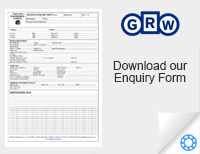All of the above are interlinked with the internal geometry of a ball bearing, If you change one of the above, then the others will also change. To ensure the optimum performance from a ball bearing, it is often more important to consider the internal geometry, especially if the bearing is going to be subjected to extreme running conditions. Great care must be taken when applying interference fits or where dis-similar materials are used (with different coefficients of expansion) over wide temperature ranges.
What is Radial play “RL”?
The radial play is the total radial displacement of the outer ring against the inner ring. Radial play has nothing to do with quality of a bearing but can be a major factor when considering bearing performance & life.
Radial Play = Outer Raceway Diameter – (Inner Raceway Diameter + 2 x Ball Diameter)
A higher radial play will:
- To a degree compensate for interference fits.
- Offset some expansion and contraction in shafts and housings due to temperature change.
- Provide a greater contact angle to allow for greater axial loads.
- Increase axial stiffness in a pre-loaded pair.
- Allow a small amount of mis-alignment.
A tighter radial play will:
- Limit the deviation of the balls within the running track to a truer circle which reduces skidding and reduces wear.
- Reduce the axial play.
- Reduce the tilt angle, vibration and noise.
What is Axial Play “AL”?
The axial play is the total axial displacement of the outer ring against the inner ring.
Where:
Da = profile diameter outer ring
Di = profile diameter inner ring
dk = ball diameter
RL = radial play
What is the Contact Angle?
The contact angle is the angle between a vertical line through the centre of the ball perpendicular to the axis of rotation and a straight line crossing the contact points of the ball at the raceways.

Where:
αo = Contact Angle
da = profile diameter outer ring
di = profile diameter inner ring
dk = Ball Diameter
RL = Radial Play

What is Tilt Angle?
The angular displacement of the inner ring axis in relation to the outer ring axis it should be kept to a minimum to ensure good contact of balls to the raceways.

What is the Running Track?
The path the balls follow around the raceway; this should be as near to a perfect circle as possible to reduce the skidding and associated wear created by the balls speeding up and slowing down during each rotation as would be the case if the inner ring were tilted causing an elliptical running track.
What is Raceway Curvature?
The raceway curvature (x) is the proportional difference between the diameter of the ball and the diameter of the raceway profile, it is usually stated as a percentage of the ball diameter.
Where:
x = Curvature
de = Raceway Profile Diameter
dk = Ball Diameter
Example:
If the chosen figure Curvature (x) = 1.14, for a given ball and a specified Radial Play (RL):
If x < 1.14 (curvature is tighter) then:
- Contact Angle (αo) is larger
- Axial Play (AL) is smaller
- Dynamic Load Capacity (C) is larger
- Static Load Capacity (Co) is larger
If x > 1.14 (curvature is shallower) then:
- Contact Angle (αo) is smaller
- Axial Play (AL) is larger
- Dynamic Load Capacity (C) is smaller
- Static Load Capacity (Co) is smaller
Please note this guide provides theoretical generalisations only. Please contact us regarding specific applications for more specific, technical advice and we will be happy to assist.










